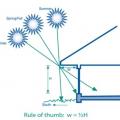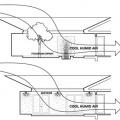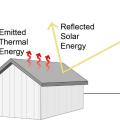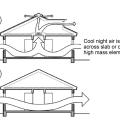Showing results 151 - 163 of 163
Using outdoor misters or spray fountains can cool the outside air before it enters the house
Using roof and wall materials with a high Solar Reflectance Index (SRI) will reduce heat gains.
Wall surfaces having high solar reflectance and high thermal emittance will remain cooler when exposed to direct sunlight.
When averaged over several years, more fatalities are caused by extreme heat than by any other weather-related hazard
When preserving a tree, construct a temporary fence around the tree canopy and post signs to keep out vehicles that might compact soil and construction waste that could contaminate the soil.
White walls and roofs; overhangs and awnings; and operable shutters and garden walls all help to keep out unwanted solar heat gain providing cool interiors for this Florida home.
Whole-house fans or wind-driven cross ventilation can be used to draw air across thermal mass for a night flush strategy
Wrong - this building provides no overhangs, minimal window shading, and clear window glass resulting in high solar heat gain.
Wrong – The south side of this building in Arizona has very little architectural or landscape shading to block solar heat gain.
Wrong – This multi family building appears to be done in traditional southwest architecture but the lack of useful overhangs, dark colored walls, and lack of tinting on windows will result in significant solar heat gain.
Wrong: Single sided ventilation without at least two windows, wing walls, and predictable wind directions is ineffective for generating wind-driven crossflow.












